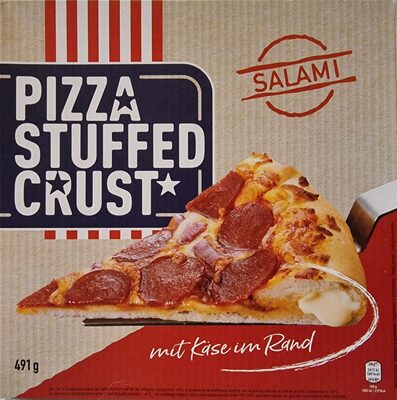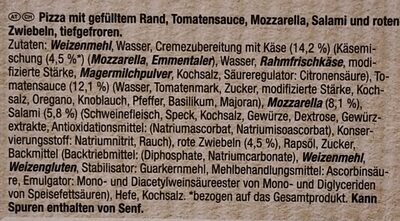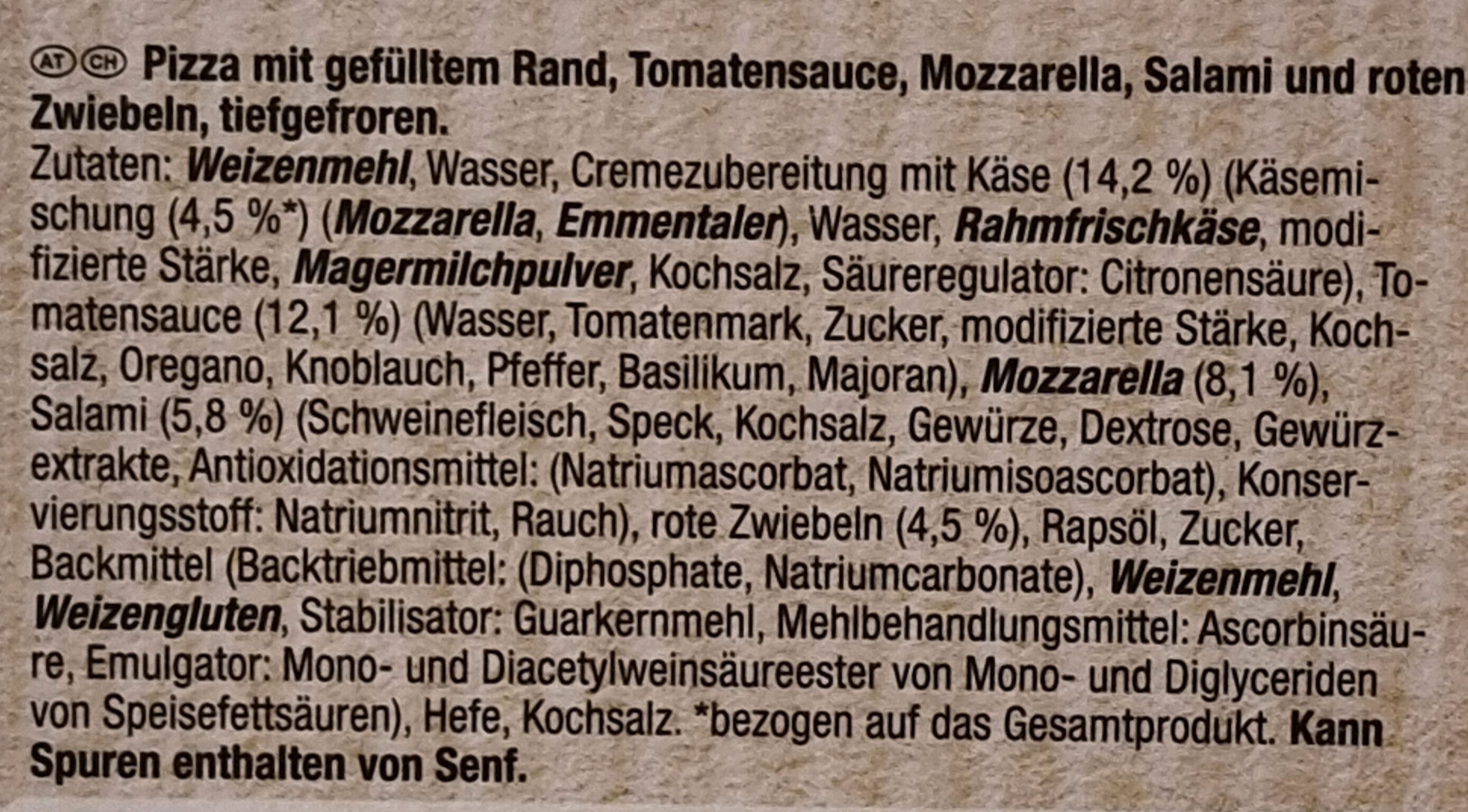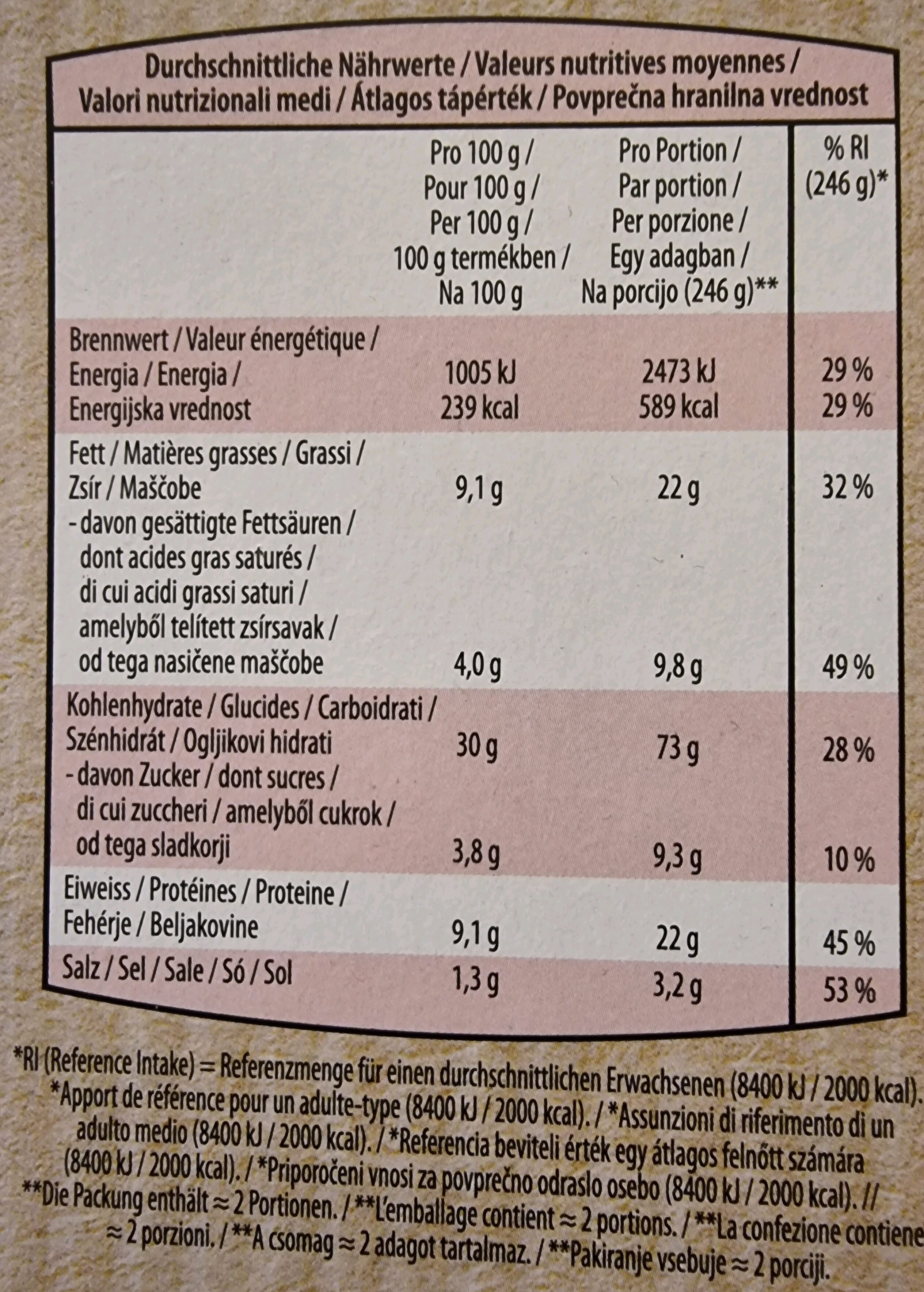Help us make food transparency the norm!
As a non-profit organization, we depend on your donations to continue informing consumers around the world about what they eat.
The food revolution starts with you!
Pizza Stuffed Crust Salami - Icewind - 491 g
Pizza Stuffed Crust Salami - Icewind - 491 g
This product page is not complete. You can help to complete it by editing it and adding more data from the photos we have, or by taking more photos using the app for Android or iPhone/iPad. Thank you!
×
Barcode: 4028855007674 (EAN / EAN-13)
Quantitéit: 491 g
Verpackungsart: en:Plastic, en:Cardboard, 23 PBD
Marken: Icewind
Kategorien: en:Frozen foods, en:Meals, en:Pizzas pies and quiches, en:Pizzas, en:Frozen pizzas and pies, en:Frozen pizzas
Geschäfter: Hofer
Country: Éisträich, Däitschland, Lëtzebuerg (Land)
Matching with your preferences
Health
Inhaltstoffer
-
55 ingredients
: Weizenmehl, Wasser, Käsezubereitung (14,2 %) (Käsemischung (4,5 %*) (Mozzarella, Emmentaler), Wasser, Rahmfrischkäse, modifizierte Stärke, Magermilchpulver, Salz, Säureregulator Citronensäure), Tomatensauce (12,1 %) (Wasser, Tomatenmark, Zucker, modifizierte Stärke, Salz, Oregano, Knoblauch, Pfeffer, Basilikum, Majoran), Mozzarella (8,1 %), Salami (5,8 %) (Schweinefleisch, Speck, Salz, Gewürze, Dextrose, Gewürzextrakte, Antioxidationsmittel (Natriumascorbat, Natriumisoascorbat), Konservierungsstoff Natriumnitrit, Rauch), rote Zwiebeln (4,5 %), Rapsöl, Zucker, Backmittel (Backtriebmittel (Diphosphate, Natriumcarbonate), Weizenmehl, Weizengluten, Stabilisator Guarkernmehl, Mehlbehandlungsmittel Ascorbinsäure, Emulgator Mono - und Diacetylweinsäureester von Mono - und Diglyceriden von Speisefettsäuren), Hefe, Salz. *bezogen auf das Gesamtprodukt.Allergenen: en:Gluten, en:MilkTraces: en:Mustard
Food processing
-
Ultra processed foods
Elements that indicate the product is in the en:4 - Ultra processed food and drink products group:
- Zousätz: E14XX
- Zousätz: E412
- Zousätz: E450
- Inhaltstoffer: Dextrose
- Inhaltstoffer: Glucose
- Inhaltstoffer: Gluten
Food products are classified into 4 groups according to their degree of processing:
- Unprocessed or minimally processed foods
- Processed culinary ingredients
- Processed foods
- Ultra processed foods
The determination of the group is based on the category of the product and on the ingredients it contains.
Zousätz
-
E250
Sodium nitrite: Sodium nitrite is the inorganic compound with the chemical formula NaNO2. It is a white to slightly yellowish crystalline powder that is very soluble in water and is hygroscopic. It is a useful precursor to a variety of organic compounds, such as pharmaceuticals, dyes, and pesticides, but it is probably best known as a food additive to prevent botulism. It is on the World Health Organization's List of Essential Medicines, the most important medications needed in a basic health system.Nitrate or nitrite -ingested- under conditions that result in endogenous nitrosation has been classified as "probably carcinogenic to humans" by International Agency for Research on Cancer -IARC-.Source: Wikipedia (Englesch)
-
E301
Sodium ascorbate: Sodium ascorbate is one of a number of mineral salts of ascorbic acid -vitamin C-. The molecular formula of this chemical compound is C6H7NaO6. As the sodium salt of ascorbic acid, it is known as a mineral ascorbate. It has not been demonstrated to be more bioavailable than any other form of vitamin C supplement.Sodium ascorbate normally provides 131 mg of sodium per 1‚000 mg of ascorbic acid -1‚000 mg of sodium ascorbate contains 889 mg of ascorbic acid and 111 mg of sodium-. As a food additive, it has the E number E301 and is used as an antioxidant and an acidity regulator. It is approved for use as a food additive in the EU, USA, and Australia and New Zealand.In in vitro studies, sodium ascorbate has been found to produce cytotoxic effects in various malignant cell lines, which include melanoma cells that are particularly susceptible.Source: Wikipedia (Englesch)
-
E316
Sodium erythorbate: Sodium erythorbate -C6H7NaO6- is a food additive used predominantly in meats, poultry, and soft drinks. Chemically, it is the sodium salt of erythorbic acid. When used in processed meat such as hot dogs and beef sticks, it increases the rate at which nitrite reduces to nitric oxide, thus facilitating a faster cure and retaining the pink coloring. As an antioxidant structurally related to vitamin C, it helps improve flavor stability and prevents the formation of carcinogenic nitrosamines. When used as a food additive, its E number is E316. The use of erythorbic acid and sodium erythorbate as a food preservative has increased greatly since the U.S. Food and Drug Administration banned the use of sulfites as preservatives in foods intended to be eaten fresh -such as ingredients for fresh salads- and as food processors have responded to the fact that some people are allergic to sulfites. It can also be found in bologna, and is occasionally used in beverages, baked goods, and potato salad.Sodium erythorbate is produced from sugars derived from different sources, such as beets, sugar cane, and corn. An urban myth claims that sodium erythorbate is made from ground earthworms; however, there is no truth to the myth. It is thought that the genesis of the legend comes from the similarity of the chemical name to the words earthworm and bait.Alternative applications include the development of additives that could be utilized as anti-oxidants in general. For instance, this substance has been implemented in the development of corrosion inhibitors for metals and it has been implemented in active packaging.Sodium erythorbate is soluble in water. The pH of the aqueous solution of the sodium salt is between 5 and 6. A 10% solution, made from commercial grade sodium erythorbate, may have a pH of 7.2 to 7.9. In its dry, crystalline state it is nonreactive. But, when in solution with water it readily reacts with atmospheric oxygen and other oxidizing agents, which makes it a valuable antioxidant.Source: Wikipedia (Englesch)
-
E330 - Zitrounesaier
Citric acid: Citric acid is a weak organic acid that has the chemical formula C6H8O7. It occurs naturally in citrus fruits. In biochemistry, it is an intermediate in the citric acid cycle, which occurs in the metabolism of all aerobic organisms. More than a million tons of citric acid are manufactured every year. It is used widely as an acidifier, as a flavoring and chelating agent.A citrate is a derivative of citric acid; that is, the salts, esters, and the polyatomic anion found in solution. An example of the former, a salt is trisodium citrate; an ester is triethyl citrate. When part of a salt, the formula of the citrate ion is written as C6H5O3−7 or C3H5O-COO-3−3.Source: Wikipedia (Englesch)
-
E412
Guar gum: Guar gum, also called guaran, is a galactomannan polysaccharide extracted from guar beans that has thickening and stabilizing properties useful in the food, feed and industrial applications. The guar seeds are mechanically dehusked, hydrated, milled and screened according to application. It is typically produced as a free-flowing, off-white powder.Source: Wikipedia (Englesch)
-
E500
Sodium carbonate: Sodium carbonate, Na2CO3, -also known as washing soda, soda ash and soda crystals, and in the monohydrate form as crystal carbonate- is the water-soluble sodium salt of carbonic acid. It most commonly occurs as a crystalline decahydrate, which readily effloresces to form a white powder, the monohydrate. Pure sodium carbonate is a white, odorless powder that is hygroscopic -absorbs moisture from the air-. It has a strongly alkaline taste, and forms a moderately basic solution in water. Sodium carbonate is well known domestically for its everyday use as a water softener. Historically it was extracted from the ashes of plants growing in sodium-rich soils, such as vegetation from the Middle East, kelp from Scotland and seaweed from Spain. Because the ashes of these sodium-rich plants were noticeably different from ashes of timber -used to create potash-, they became known as "soda ash". It is synthetically produced in large quantities from salt -sodium chloride- and limestone by a method known as the Solvay process. The manufacture of glass is one of the most important uses of sodium carbonate. Sodium carbonate acts as a flux for silica, lowering the melting point of the mixture to something achievable without special materials. This "soda glass" is mildly water-soluble, so some calcium carbonate is added to the melt mixture to make the glass produced insoluble. This type of glass is known as soda lime glass: "soda" for the sodium carbonate and "lime" for the calcium carbonate. Soda lime glass has been the most common form of glass for centuries. Sodium carbonate is also used as a relatively strong base in various settings. For example, it is used as a pH regulator to maintain stable alkaline conditions necessary for the action of the majority of photographic film developing agents. It acts as an alkali because when dissolved in water, it dissociates into the weak acid: carbonic acid and the strong alkali: sodium hydroxide. This gives sodium carbonate in solution the ability to attack metals such as aluminium with the release of hydrogen gas.It is a common additive in swimming pools used to raise the pH which can be lowered by chlorine tablets and other additives which contain acids. In cooking, it is sometimes used in place of sodium hydroxide for lyeing, especially with German pretzels and lye rolls. These dishes are treated with a solution of an alkaline substance to change the pH of the surface of the food and improve browning. In taxidermy, sodium carbonate added to boiling water will remove flesh from the bones of animal carcasses for trophy mounting or educational display. In chemistry, it is often used as an electrolyte. Electrolytes are usually salt-based, and sodium carbonate acts as a very good conductor in the process of electrolysis. In addition, unlike chloride ions, which form chlorine gas, carbonate ions are not corrosive to the anodes. It is also used as a primary standard for acid-base titrations because it is solid and air-stable, making it easy to weigh accurately.Source: Wikipedia (Englesch)
Analys vun den Inhaltstoffer
-
en:Palm oil free
No ingredients containing palm oil detected
Unrecognized ingredients: de:rahmfrischkäse, de:emulgator-mono-und-diacetylweinsäureester-von-mono-und-diglyceriden-von-speisefettsäuren, de:bezogen-auf-das-gesamtproduktSome ingredients could not be recognized.
We need your help!
You can help us recognize more ingredients and better analyze the list of ingredients for this product and others:
- Edit this product page to correct spelling mistakes in the ingredients list, and/or to remove ingredients in other languages and sentences that are not related to the ingredients.
- Add new entries, synonyms or translations to our multilingual lists of ingredients, ingredient processing methods, and labels.
If you would like to help, join the #ingredients channel on our Slack discussion space and/or learn about ingredients analysis on our wiki. Thank you!
-
en:Non-vegan
Non-vegan ingredients: fr:Préparation fromagère, en:Mixed cheese, Mozzarella, Emmentaler, en:Skimmed milk powder, Mozzarella, Salami, en:Pork meat, en:BaconSome ingredients could not be recognized.
We need your help!
You can help us recognize more ingredients and better analyze the list of ingredients for this product and others:
- Edit this product page to correct spelling mistakes in the ingredients list, and/or to remove ingredients in other languages and sentences that are not related to the ingredients.
- Add new entries, synonyms or translations to our multilingual lists of ingredients, ingredient processing methods, and labels.
If you would like to help, join the #ingredients channel on our Slack discussion space and/or learn about ingredients analysis on our wiki. Thank you!
-
en:Non-vegetarian
Non-vegetarian ingredients: Salami, en:Pork meat, en:BaconSome ingredients could not be recognized.
We need your help!
You can help us recognize more ingredients and better analyze the list of ingredients for this product and others:
- Edit this product page to correct spelling mistakes in the ingredients list, and/or to remove ingredients in other languages and sentences that are not related to the ingredients.
- Add new entries, synonyms or translations to our multilingual lists of ingredients, ingredient processing methods, and labels.
If you would like to help, join the #ingredients channel on our Slack discussion space and/or learn about ingredients analysis on our wiki. Thank you!
-
Details of the analysis of the ingredients
We need your help!
Some ingredients could not be recognized.
We need your help!
You can help us recognize more ingredients and better analyze the list of ingredients for this product and others:
- Edit this product page to correct spelling mistakes in the ingredients list, and/or to remove ingredients in other languages and sentences that are not related to the ingredients.
- Add new entries, synonyms or translations to our multilingual lists of ingredients, ingredient processing methods, and labels.
If you would like to help, join the #ingredients channel on our Slack discussion space and/or learn about ingredients analysis on our wiki. Thank you!
: Weizenmehl, Wasser, Käsezubereitung 14.2% (Käsemischung 4.5% (Mozzarella, Emmentaler), Wasser, Rahmfrischkäse, modifizierte Stärke, Magermilchpulver, Salz, Säureregulator (Citronensäure)), Tomatensauce 12.1% (Wasser, Tomatenmark, Zucker, modifizierte Stärke, Salz, Oregano, Knoblauch, Pfeffer, Basilikum, Majoran), Mozzarella 8.1%, Salami 5.8% (Schweinefleisch, Speck, Salz, Gewürze, Dextrose, Gewürzextrakte, Antioxidationsmittel (Natriumascorbat, Natriumisoascorbat), Konservierungsstoff (Natriumnitrit), Rauch), rote Zwiebeln 4.5%, Rapsöl, Zucker, Backmittel (Backtriebmittel (Diphosphate, Natriumcarbonate), Weizenmehl, Weizengluten, Stabilisator (Guarkernmehl), Mehlbehandlungsmittel (Ascorbinsäure), Emulgator mono- und Diacetylweinsäureester von mono- und Diglyceriden von Speisefettsäuren), Hefe, Salz, bezogen auf das Gesamtprodukt- Weizenmehl -> en:wheat-flour - vegan: yes - vegetarian: yes - ciqual_proxy_food_code: 9410 - percent_min: 14.2 - percent_max: 41.1
- Wasser -> en:water - vegan: yes - vegetarian: yes - ciqual_food_code: 18066 - percent_min: 14.2 - percent_max: 27.65
- Käsezubereitung -> fr:preparation-fromagere - vegan: no - vegetarian: maybe - ciqual_proxy_food_code: 12999 - percent_min: 14.2 - percent: 14.2 - percent_max: 14.2
- Käsemischung -> en:mixed-cheese - vegan: no - vegetarian: maybe - ciqual_proxy_food_code: 12999 - percent_min: 4.5 - percent: 4.5 - percent_max: 4.5
- Mozzarella -> en:mozzarella - vegan: no - vegetarian: maybe - ciqual_food_code: 19590 - percent_min: 2.25 - percent_max: 4.5
- Emmentaler -> en:emmental - vegan: no - vegetarian: maybe - ciqual_food_code: 12115 - percent_min: 0 - percent_max: 2.25
- Wasser -> en:water - vegan: yes - vegetarian: yes - ciqual_food_code: 18066 - percent_min: 1.61666666666667 - percent_max: 4.5
- Rahmfrischkäse -> de:rahmfrischkäse - percent_min: 1.04 - percent_max: 4.5
- modifizierte Stärke -> en:modified-starch - vegan: yes - vegetarian: yes - ciqual_proxy_food_code: 9510 - percent_min: 0.175 - percent_max: 3.55
- Magermilchpulver -> en:skimmed-milk-powder - vegan: no - vegetarian: yes - ciqual_food_code: 19054 - percent_min: 0 - percent_max: 2.63611111111111
- Salz -> en:salt - vegan: yes - vegetarian: yes - ciqual_food_code: 11058 - percent_min: 0 - percent_max: 1.3
- Säureregulator -> en:acidity-regulator - percent_min: 0 - percent_max: 1.3
- Citronensäure -> en:e330 - vegan: yes - vegetarian: yes - percent_min: 0 - percent_max: 1.3
- Käsemischung -> en:mixed-cheese - vegan: no - vegetarian: maybe - ciqual_proxy_food_code: 12999 - percent_min: 4.5 - percent: 4.5 - percent_max: 4.5
- Tomatensauce -> en:tomato-sauce - vegan: maybe - vegetarian: maybe - ciqual_proxy_food_code: 11107 - percent_min: 12.1 - percent: 12.1 - percent_max: 12.1
- Wasser -> en:water - vegan: yes - vegetarian: yes - ciqual_food_code: 18066 - percent_min: 1.21 - percent_max: 12.1
- Tomatenmark -> en:tomato-puree - vegan: yes - vegetarian: yes - ciqual_food_code: 20170 - percent_min: 0 - percent_max: 6.05
- Zucker -> en:sugar - vegan: yes - vegetarian: yes - ciqual_proxy_food_code: 31016 - percent_min: 0 - percent_max: 3.8
- modifizierte Stärke -> en:modified-starch - vegan: yes - vegetarian: yes - ciqual_proxy_food_code: 9510 - percent_min: 0 - percent_max: 3.025
- Salz -> en:salt - vegan: yes - vegetarian: yes - ciqual_food_code: 11058 - percent_min: 0 - percent_max: 1.3
- Oregano -> en:oregano - vegan: yes - vegetarian: yes - ciqual_proxy_food_code: 11035 - percent_min: 0 - percent_max: 1.3
- Knoblauch -> en:garlic - vegan: yes - vegetarian: yes - ciqual_food_code: 11000 - percent_min: 0 - percent_max: 1.3
- Pfeffer -> en:pepper - vegan: yes - vegetarian: yes - percent_min: 0 - percent_max: 1.3
- Basilikum -> en:basil - vegan: yes - vegetarian: yes - ciqual_food_code: 11033 - percent_min: 0 - percent_max: 1.3
- Majoran -> en:marjoram - vegan: yes - vegetarian: yes - percent_min: 0 - percent_max: 1.3
- Mozzarella -> en:mozzarella - vegan: no - vegetarian: maybe - ciqual_food_code: 19590 - percent_min: 8.1 - percent: 8.1 - percent_max: 8.1
- Salami -> en:salami - vegan: no - vegetarian: no - ciqual_food_code: 30350 - percent_min: 5.8 - percent: 5.8 - percent_max: 5.8
- Schweinefleisch -> en:pork-meat - vegan: no - vegetarian: no - ciqual_proxy_food_code: 28205 - percent_min: 0.644444444444444 - percent_max: 5.8
- Speck -> en:bacon - vegan: no - vegetarian: no - ciqual_food_code: 28858 - percent_min: 0 - percent_max: 2.9
- Salz -> en:salt - vegan: yes - vegetarian: yes - ciqual_food_code: 11058 - percent_min: 0 - percent_max: 1.3
- Gewürze -> en:spice - vegan: yes - vegetarian: yes - percent_min: 0 - percent_max: 1.3
- Dextrose -> en:dextrose - vegan: yes - vegetarian: yes - ciqual_proxy_food_code: 31016 - percent_min: 0 - percent_max: 1.16
- Gewürzextrakte -> en:spice-extract - vegan: yes - vegetarian: yes - percent_min: 0 - percent_max: 0.966666666666667
- Antioxidationsmittel -> en:antioxidant - percent_min: 0 - percent_max: 0.828571428571429
- Natriumascorbat -> en:e301 - vegan: yes - vegetarian: yes - percent_min: 0 - percent_max: 0.828571428571429
- Natriumisoascorbat -> en:e316 - vegan: yes - vegetarian: yes - percent_min: 0 - percent_max: 0.414285714285714
- Konservierungsstoff -> en:preservative - percent_min: 0 - percent_max: 0.725
- Natriumnitrit -> en:e250 - vegan: yes - vegetarian: yes - percent_min: 0 - percent_max: 0.725
- Rauch -> en:smoke - vegan: yes - vegetarian: yes - percent_min: 0 - percent_max: 0.725
- rote Zwiebeln -> en:red-onion - vegan: yes - vegetarian: yes - ciqual_food_code: 20034 - percent_min: 4.5 - percent: 4.5 - percent_max: 4.5
- Rapsöl -> en:rapeseed-oil - vegan: yes - vegetarian: yes - from_palm_oil: no - percent_min: 0 - percent_max: 4.5
- Zucker -> en:sugar - vegan: yes - vegetarian: yes - ciqual_proxy_food_code: 31016 - percent_min: 0 - percent_max: 3.8
- Backmittel -> en:bread-improver - percent_min: 0 - percent_max: 3.8
- Backtriebmittel -> en:raising-agent - percent_min: 0 - percent_max: 3.8
- Diphosphate -> en:e450 - vegan: yes - vegetarian: yes - percent_min: 0 - percent_max: 3.8
- Natriumcarbonate -> en:e500 - vegan: yes - vegetarian: yes - percent_min: 0 - percent_max: 1.9
- Weizenmehl -> en:wheat-flour - vegan: yes - vegetarian: yes - ciqual_proxy_food_code: 9410 - percent_min: 0 - percent_max: 1.9
- Weizengluten -> en:wheat-gluten - vegan: yes - vegetarian: yes - percent_min: 0 - percent_max: 1.26666666666667
- Stabilisator -> en:stabiliser - percent_min: 0 - percent_max: 0.95
- Guarkernmehl -> en:e412 - vegan: yes - vegetarian: yes - percent_min: 0 - percent_max: 0.95
- Mehlbehandlungsmittel -> en:flour-treatment-agent - percent_min: 0 - percent_max: 0.76
- Ascorbinsäure -> en:e300 - vegan: yes - vegetarian: yes - percent_min: 0 - percent_max: 0.76
- Emulgator mono- und Diacetylweinsäureester von mono- und Diglyceriden von Speisefettsäuren -> de:emulgator-mono-und-diacetylweinsäureester-von-mono-und-diglyceriden-von-speisefettsäuren - percent_min: 0 - percent_max: 0.633333333333333
- Backtriebmittel -> en:raising-agent - percent_min: 0 - percent_max: 3.8
- Hefe -> en:yeast - vegan: yes - vegetarian: yes - percent_min: 0 - percent_max: 3.8
- Salz -> en:salt - vegan: yes - vegetarian: yes - ciqual_food_code: 11058 - percent_min: 0 - percent_max: 1.3
- bezogen auf das Gesamtprodukt -> de:bezogen-auf-das-gesamtprodukt - percent_min: 0 - percent_max: 1.3
Ernährung
-
Average nutritional quality
⚠ ️Warning: the amount of fiber is not specified, their possible positive contribution to the grade could not be taken into account.⚠ ️Warning: the amount of fruits, vegetables and nuts is not specified on the label, it was estimated from the list of ingredients: 9This product is not considered a beverage for the calculation of the Nutri-Score.
Positive points: 5
- Protéinen/Ëiweisser: 5 / 5 (value: 9.1, rounded value: 9.1)
- Fiber: 0 / 5 (value: 0, rounded value: 0)
- Fruits, vegetables, nuts, and colza/walnut/olive oils: 0 / 5 (value: 9.557578125, rounded value: 9.6)
Negative points: 10
- Energie: 2 / 10 (value: 1005, rounded value: 1005)
- Zocker: 0 / 10 (value: 3.8, rounded value: 3.8)
- Gesättescht Fetter: 3 / 10 (value: 4, rounded value: 4)
- Sodium: 5 / 10 (value: 520, rounded value: 520)
The points for proteins are counted because the negative points are less than 11.
Nutritional score: (10 - 5)
Nutri-Score:
-
Nutrient levels
-
Fat in moderate quantity (9.1%)
What you need to know- A high consumption of fat, especially saturated fats, can raise cholesterol, which increases the risk of heart diseases.
Recommendation: Limit the consumption of fat and saturated fat- Choose products with lower fat and saturated fat content.
-
Saturated fat in moderate quantity (4%)
What you need to know- A high consumption of fat, especially saturated fats, can raise cholesterol, which increases the risk of heart diseases.
Recommendation: Limit the consumption of fat and saturated fat- Choose products with lower fat and saturated fat content.
-
Sugars in low quantity (3.8%)
What you need to know- A high consumption of sugar can cause weight gain and tooth decay. It also augments the risk of type 2 diabetes and cardio-vascular diseases.
Recommendation: Limit the consumption of sugar and sugary drinks- Sugary drinks (such as sodas, fruit beverages, and fruit juices and nectars) should be limited as much as possible (no more than 1 glass a day).
- Choose products with lower sugar content and reduce the consumption of products with added sugars.
-
Salt in moderate quantity (1.3%)
What you need to know- A high consumption of salt (or sodium) can cause raised blood pressure, which can increase the risk of heart disease and stroke.
- Many people who have high blood pressure do not know it, as there are often no symptoms.
- Most people consume too much salt (on average 9 to 12 grams per day), around twice the recommended maximum level of intake.
Recommendation: Limit the consumption of salt and salted food- Reduce the quantity of salt used when cooking, and don't salt again at the table.
- Limit the consumption of salty snacks and choose products with lower salt content.
-
-
Ernährungangaben
Ernährungangaben As sold
for 100 g / 100 mlCompared to: en:Pizzas Energie 1.005 kj
(239 kcal)+9 % Fat 9,1 g +17 % Saturated fat 4 g +23 % Carbohydrates 30 g +11 % Sugars 3,8 g +17 % Fiber ? Protein 9,1 g +3 % Salt 1,3 g +16 % Fruits‚ vegetables‚ nuts and rapeseed‚ walnut and olive oils (estimate from ingredients list analysis) 9,558 %
Environment
-
Eco-Score not computed - Unknown environmental impact
We could not compute the Eco-Score of this product as it is missing some data, could you help complete it?Could you add a precise product category so that we can compute the Eco-Score? Add a category
Verpackungsart
-
Missing packaging information for this product
⚠ ️ The information about the packaging of this product is not filled in.Take a photo of the recycling information Take a photo of the recycling information
Transportation
-
Origins of ingredients
Missing origins of ingredients information
⚠ ️ The origins of the ingredients of this product are not indicated.
If they are indicated on the packaging, you can modify the product sheet and add them.
If you are the manufacturer of this product, you can send us the information with our free platform for producers.Add the origins of ingredients for this product Add the origins of ingredients for this product
Report a problem
-
Incomplete or incorrect information?
Category, labels, ingredients, allergens, nutritional information, photos etc.
If the information does not match the information on the packaging, please complete or correct it. Open Food Facts is a collaborative database, and every contribution is useful for all.
Data sources
Product added on vun openfoodfacts-contributors
Last edit of product page on vun fffood.
Produkt Säit och geännert vun anonvie, kiliweb, prepperapp, yuka.R1prZUU2Y05wcU1oeC9RR3BqbjczZWx2eWNlUmJYK3lDK01xSVE9PQ.










